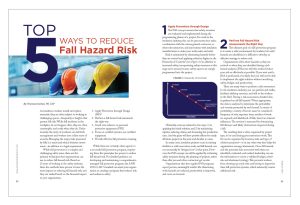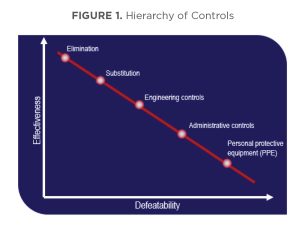Top 5 Ways to Reduce Fall Hazard Risk
As insulation workers install and replace materials, they are often subject to working in challenging spaces—frequently at heights that present fall risk. While fall incidents in the workplace do not happen often, they are often catastrophic and costly when they do. Unfortunately, the rarity of accidents can lull both management and workers into a false sense of security. Managing the major risks presented by falls is a smart and ethical business investment—in addition to a legal requirement.
While fall protection is a complex and challenging safety issue, there are five primary techniques that organizations can use to reduce fall hazard risk. Based on 25 years of working in the safety industry, these five methods have proven to have the most impact on reducing fall hazard risk, and they are ranked based on the financial impact to your organization.
- Apply Prevention through Design (PtD)1
- Perform a fall hazard risk assessment the right way
- Avoid over-reliance on personal protective equipment (PPE)
- Focus on certified systems, not certified equipment
- Provide effective fall prevention training
While there are certainly other aspects to a successful fall protection program, employing these five principles has proven to reduce fall hazard risk. For detailed guidance on developing and maintaining a comprehensive managed fall protection program, the ANSI Z359.2-2017 standard can assist your organization in creating a program that reduces risk and enhances safety.
1. Apply Prevention through Design
The PtD concept ensures that safety measures are evaluated and implemented during the programming phases of a project. For work in the insulation industry, this can be preconstruction tasks; coordination with the owner, general contractor, or other subcontractors; and innovations with insulation manufacturers to make your work easier and safer.
Risk is minimized by eliminating hazards before they are created and applying solutions higher in the Hierarchy of Controls2 (see Figure 1). In addition to increased safety, incorporating safety measures at this stage saves money because safety aspects are simply programmed into the project.
Ultimately, costs are reduced in two ways: 1) in applying the initial solution; and 2) by minimizing injuries, reducing claims, and decreasing lost production time. And the gains will have positive effects for nearly all future projects in the years and decades to come.
In many cases, insulation projects occur in existing facilities or with renovation work, and fall hazards cannot necessarily be “designed out” at that point. However, the PtD concept can still be applied by evaluating safety measures during the planning of projects, rather than after you and other contractors get on site.
Organizations that have applied PtD programs report proven, meaningful results: life-threatening work hazards are reduced, productivity is improved, and costs are lowered.
2. Perform Fall Hazard Risk Assessments the Right Way
The ultimate goal of a fall protection program is to create a safer environment for workers, but until hazards are identified, it is difficult to develop an effective strategy to reduce risk.
Organizations often abate hazards as they are noticed or when they are identified during a job hazard analysis (JHA), but will this method reduce your risk as effectively as possible? If you wait until a JHA is performed, it is likely that you will not be able to implement the right solution without sacrificing safety, budget, and productivity.
There are many ways to perform a risk assessment. In the insulation industry, you can perform job walks, facilitate tabletop exercises, and talk to the workers in the field. During a risk assessment, detailed data is gathered on all fall hazards. When appropriate, the data is analyzed to determine the probability and severity presented by each hazard. In terms of probability, a variety of factors must be considered: frequency of task; exposure time; number of workers exposed; and likelihood of falls, based on external influences. The severity is measured by determining fall distance and likely obstructions impacted during a fall.
The resulting data is often organized by project type, to be used during preconstruction work. This list can be organized by location, task, and type of solution proposed—or in any other way that helps the organization manage abatements. Once fall hazards and the potential risks associated with them are identified, evaluated, and ranked, leadership can use the information to create a validated budget, schedule, and abatement strategy. This prevents workers from showing up at job sites and having to improvise their fall protection systems, which inherently creates additional risk.
3. Avoid Over-Reliance on Personal Protective Equipment
In the United States, overall fall fatalities and the associated costs are increasing, despite the fact that the amount of money spent on PPE has doubled. Clearly, having equipment is not enough to ensure safety.
Organizations often become overwhelmed by the options and variables available in the market and decide that PPE solutions are the answer. However, PPE should always be the last choice for a solution because there are so many opportunities for personal fall arrest systems to fail.
In addition to the condition of individual components, some potential concerns with equipment are:
- Anchorage height and, in too many cases, foot-level tie-offs;
- Adherence to freefall limitations;
- Fall clearance requirements—will a falling worker hit something on the way down before the fall protection system arrests the fall;
- Swing fall hazards;
- Proper equipment specified for the system;
- Equipment component compatibility; and
- Potential for misuse.
Selecting and implementing fall protection solutions are the most visible aspects of a fall protection program. They are also the most costly. So, when selecting the best equipment, you have the most to lose. You lose time, money, safety, and productivity when you implement the wrong solutions. When selecting abatement solutions, guidance should be taken from the Hierarchy of Controls. This widely accepted strategy measures the effectiveness and defeatability of hazard abatement methods. As shown in Figure 1, PPE is the least effective and most defeatable solution, and therefore holds the lowest position in the hierarchy. Said another way, PPE solutions are so easy to overcome that they leave an organization with significant residual risk.
To reduce the most risk, organizations should favor elimination, substitution, and engineering control solutions. With engineering control solutions, employees have to actively overcome barriers to put themselves at risk. On the other hand, using PPE-based solutions means you have not removed the workers from the hazard, or the hazard from
the workers.
4. Focus on Certified Systems—Not Just Equipment
Competent persons and users of fall protection systems may know that their equipment meets the latest ANSI Z359 standards, but they cannot typically confirm that the whole system meets the standards. Documentation must show that the system is fit for service and that workers can use it safely.
There are five primary elements to consider when certifying a fall protection system. Each of the fundamentals listed below must be evaluated to ensure that all aspects of a given system are acceptable for use.
- Suitability of system
- Anchorages
- Equipment
- Procedures
- Training
Well-planned and properly designed fall protection systems can only function if they are installed and used properly. Organizations that engage trained professionals or have in-house teams to certify the entire process—from initial planning through implementation to ongoing evaluation—dramatically increase the reliability of installed fall protection systems.
The certification process is especially important for active fall protection systems using a full-body harness, since properly functioning and usable systems can mean the difference between life and death.
5. Provide Effective Fall Protection Training
Only well-informed individuals can make the right decisions about fall protection. That is why it is critical to ensure proper training for the people who supervise or use fall protection systems (Figure 2).
The goal of fall protection training is to change behavior. To truly impact a safety program, training needs to include more than just instruction on regulations and equipment use. Participants need the skills and tools to solve fall protection issues before they arise, so they do not rely on less effective reactive approaches or improvise systems in the field.
Adult learners have a variety of learning preferences, so it is important to use a variety of teaching methods. Combining lecture, multimedia applications, and hands-on exercises increases ownership, understanding, and retention of critical material. Participants grasp training content best when it is customized to the fall hazards they confront daily. Regardless of the training approach, it must be customized to the workers and their unique environments and responsibilities.
Because different employees have different responsibilities related to fall protection, there are various levels of fall protection training to consider. The ANSI Z359.2 standard outlines the following levels of training, including required training content for each type of training:
- Awareness,
- Authorized person,
- Competent person,
- Qualified person, and
- Refresher training.
Regular, ongoing training will also support the other major elements of a fall protection program and increase the effectiveness of each step.
Conclusion
The nature and location of many insulation projects invariably puts workers at risk. However, when an organization proactively focuses on identifying and addressing fall risk and ensuring proper equipment and training, the result is increased safety and reduced risk.
References
1. The National Institute for Occupational Safety and Health, https://www.cdc.gov/niosh/topics/ptd/default.html
2. https://www.cdc.gov/niosh/topics/hierarchy/default.html
Note: Figures provided by the author.



